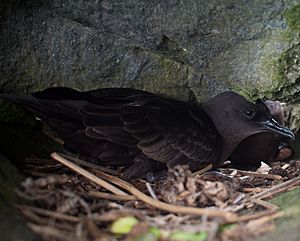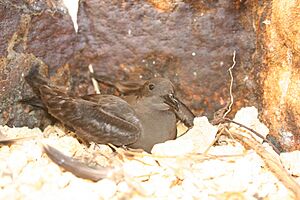Bulwer's petrel facts for kids
Quick facts for kids Bulwer's petrel |
|
|---|---|
 |
|
| Conservation status | |
| Scientific classification | |
| Genus: |
Bulweria
|
| Species: |
bulwerii
|
Bulwer's petrel (Bulweria bulwerii) is a small petrel bird. It belongs to the family called Procellariidae. This bird is named after an English naturalist named James Bulwer.
Contents
What Does a Bulwer's Petrel Look Like?
This petrel has very long wings. It is about 25–29 cm (9.8–11.4 in) long. Its wings can spread up to 78–90 cm (31–35 in) wide. It has mostly brown feathers and a long, pointed tail. When it flies, it looks like it's twisting and bouncing. It picks up tiny food from the ocean surface.

Where Do Bulwer's Petrels Live?
These birds live in warm parts of the Atlantic, Indian, and Pacific oceans. They live all year in places like Cabo Verde, China, Japan, and Taiwan. They also breed in the Macaronesian Islands and Portugal. In the Pacific, they breed from eastern China to the Hawaiian Islands.
Bulwer's petrels spend most of their lives far out at sea. They only come to land during their breeding season. Sometimes, they are seen in places like Ireland, France, and Italy. They have also been spotted rarely off the coasts of California and North Carolina in North America.
How Do Bulwer's Petrels Behave?
Breeding Habits
Bulwer's petrels build their nests in different places. They use burrows, plants, or cracks in cliffs. They also nest under driftwood or other things left by people. They do not dig these burrows themselves.
The breeding season for these petrels starts in April and May. When it's time to breed, they usually go back to the same nest site. They also mate with the same partner as before. Many pairs, sometimes 7,000 to 9,000, gather in colonies to breed.
A female petrel usually lays one egg. Young birds might sometimes lay two eggs. The egg is a beige-white color. It is usually about 42 by 30 millimetres (1.7 in × 1.2 in) in size. Both the male and female birds take turns sitting on the egg. This incubation period lasts for 42 to 46 days. They both also help feed their chicks after they hatch.
What Do They Eat?
Bulwer's petrels spend most of their time far out at sea. They are rarely near land, except when they are breeding. Their main food is small fish, like sardines. They also eat squid. Sometimes, they eat small crabs, krill, shrimp, and tiny ocean creatures called plankton.
What Threats Do They Face?
In the North East Atlantic, Bulwer's petrels face dangers from predators. These include cats and rats. In some places, like the Azores, they nest on steep cliffs to stay safe from cats. On Madeira, Madeiran wall lizards sometimes eat petrel chicks. However, this does not seem to affect the whole petrel population much.
Some colonies, like those in the Desertas Islands, have been affected by people. People used to catch these birds for food or fishing bait. This still happens a little in other places. But in the Salvage Islands, it stopped when the islands became a nature reserve.
Bulwer's petrels are also at risk from oil spills and other types of ocean pollution. Light pollution at night can also be a problem for them. New buildings for tourism might also reduce the places where they can nest.
See also
 In Spanish: Petrel de Bulwer para niños
In Spanish: Petrel de Bulwer para niños



